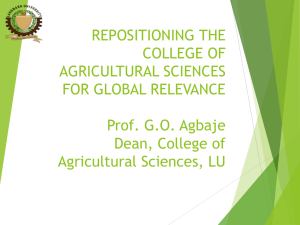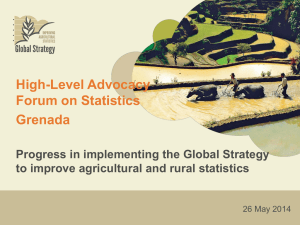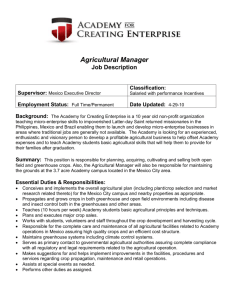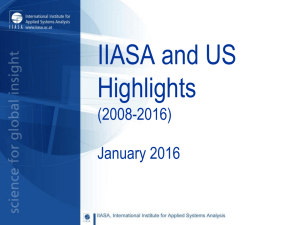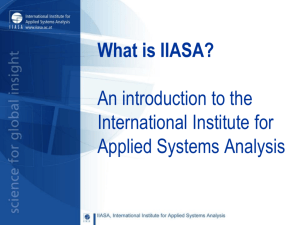wene55-sup-0001-FigureS1
advertisement
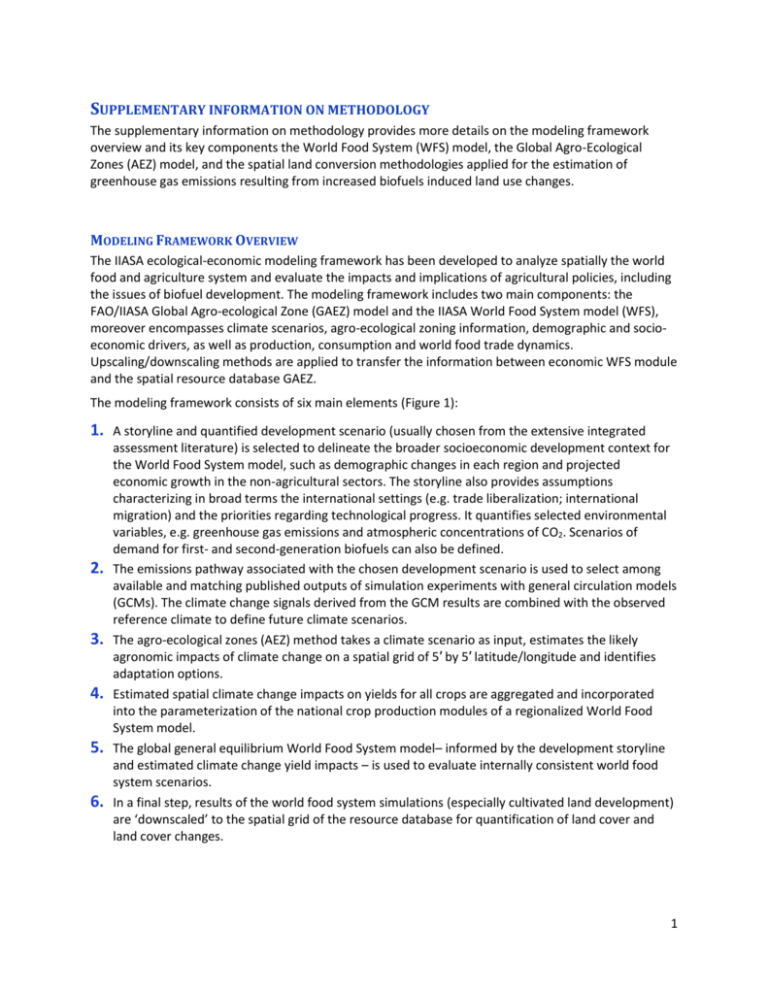
SUPPLEMENTARY INFORMATION ON METHODOLOGY The supplementary information on methodology provides more details on the modeling framework overview and its key components the World Food System (WFS) model, the Global Agro-Ecological Zones (AEZ) model, and the spatial land conversion methodologies applied for the estimation of greenhouse gas emissions resulting from increased biofuels induced land use changes. MODELING FRAMEWORK OVERVIEW The IIASA ecological-economic modeling framework has been developed to analyze spatially the world food and agriculture system and evaluate the impacts and implications of agricultural policies, including the issues of biofuel development. The modeling framework includes two main components: the FAO/IIASA Global Agro-ecological Zone (GAEZ) model and the IIASA World Food System model (WFS), moreover encompasses climate scenarios, agro-ecological zoning information, demographic and socioeconomic drivers, as well as production, consumption and world food trade dynamics. Upscaling/downscaling methods are applied to transfer the information between economic WFS module and the spatial resource database GAEZ. The modeling framework consists of six main elements (Figure 1): 1. 2. 3. 4. 5. 6. A storyline and quantified development scenario (usually chosen from the extensive integrated assessment literature) is selected to delineate the broader socioeconomic development context for the World Food System model, such as demographic changes in each region and projected economic growth in the non-agricultural sectors. The storyline also provides assumptions characterizing in broad terms the international settings (e.g. trade liberalization; international migration) and the priorities regarding technological progress. It quantifies selected environmental variables, e.g. greenhouse gas emissions and atmospheric concentrations of CO2. Scenarios of demand for first- and second-generation biofuels can also be defined. The emissions pathway associated with the chosen development scenario is used to select among available and matching published outputs of simulation experiments with general circulation models (GCMs). The climate change signals derived from the GCM results are combined with the observed reference climate to define future climate scenarios. The agro-ecological zones (AEZ) method takes a climate scenario as input, estimates the likely agronomic impacts of climate change on a spatial grid of 5′ by 5′ latitude/longitude and identifies adaptation options. Estimated spatial climate change impacts on yields for all crops are aggregated and incorporated into the parameterization of the national crop production modules of a regionalized World Food System model. The global general equilibrium World Food System model– informed by the development storyline and estimated climate change yield impacts – is used to evaluate internally consistent world food system scenarios. In a final step, results of the world food system simulations (especially cultivated land development) are ‘downscaled’ to the spatial grid of the resource database for quantification of land cover and land cover changes. 1 Agro-ecological suitability and land productivity 3 2 Climate impact response relations Climate model 1 Development 4 Production Demand Trade Global Food-FeedBiofuel System scenario World Market 5 6 Spatial distribution of land use Figure 1. Ecological-economic modeling framework World Food System (WFS) model The World Food System model provides a framework for analyzing—in annual steps—how much food will be produced and consumed in the world, where it will be produced and consumed, and the trade and financial flows related to such activities. It is used to simulate alternative development scenarios, to investigate climate change impacts on food provision, and to assess the implications of alternative biofuel targets. It provides a framework for analyzing the world food system, viewing national food and agricultural components as embedded in national economies, which in turn interact with each other at the international trade level. For current applications, a state-of-the-art ecological-economic modeling framework is used that includes as three major components: the Global Agro-ecological Zone (GAEZ) model, the WFS model, and upscaling/downscaling methods to transfer information between these modules and the spatial resource database. The modeling framework and models have been developed to analyze spatially the world food and agriculture system, its impacts on food security and the environment and to evaluate the impacts and implications of agricultural policies. IIASA released a first version of the WFS model in 1988, termed the Basic Linked System, in response to the energy and food crisis of the1980s. The WFS model and its databases have been updated and 2 extended on several occasions. 1,2,3,4,5,6,7 The model has been calibrated and validated over past time windows. Methodology / Data generation The WFS is a global recursive dynamic applied general equilibrium model made up of 34 national and/or regional geographical components. The individual national/regional models are linked together by means of a world market, where international clearing prices are computed to equalize global demand with supply. The model is formulated as a recursively dynamic system, working in annual steps, the outcome of each step being affected by the outcomes of earlier ones. Each individual model covers the whole economy of the respective geographical area. For the purpose of international linkage, production, consumption, and trade are aggregated to nine agricultural sectors and one non-agricultural sector. All physical and financial accounts are balanced and mutually consistent: the production, consumption, and financial ones at the national level, and the trade and financial flows at the global level (Figure 2). COUNTRY A EXCHANGE EQUILIBRIUM PRODUCTION Non-agriculture production Prices, consumption, stocks, net exports to satisfy: Agriculture production Production inputs: • Budget constraint • Market clearance • Trade balance • Trade quota • Land • Labour • Capital • Fertilizer • Others GOVERNMENT POLICIES Target price, tariffs, taxes, quota, etc. International commodity prices PW Net trade EA COUNTRY B PW WORLD MARKETS International prices to satisfy: • commodity balances • financial transfer balance EC PW COUNTRY C ED EB EE PW COUNTRY D PW COUNTRY E Figure 2. Schematic representation of the World Food System model 3 The world food system model is an applied general equilibrium (AGE) model system. While focusing on agriculture, this necessitates that also all other economic activities are represented in the model. Financial flows as well as commodity flows within a country and at the international level are kept consistent, in the sense that they must balance, by imposing a system of budget constraints and marketclearing conditions. Whatever is produced will be demanded, either for human consumption, feed, biofuel use, or as intermediate input. Alternatively, commodities can be exported or put into storage. Consistency of financial flows is imposed at the level of the economic agents in the model (individual income groups, governments, etc.), at the national as well as the international level. This implies that total expenditures cannot exceed total income from economic activities and from abroad, in the form of financial transfers, minus savings. On a global scale, not more can be spent than what is earned. Each individual model component focuses primarily on the agricultural sector, but includes also a simple representation of the entire economy as necessary to capture essential dynamics among capital, labor and land. For the purpose of international linkage, production, consumption and trade of goods and services are aggregated into nine main agricultural sectors, namely: wheat; rice; coarse grains; bovine and ovine meat; dairy products; other meat and fish; oilseed cakes and protein meals; other food; nonfood agriculture. The rest of the economy is coarsely aggregated into one simplified non-agricultural sector. Agricultural commodities may be used in the model for human consumption, feed, as biofuel feedstock, for intermediate consumption, and stock accumulation. The non-agricultural commodity contributes also as investment, and as input for processing and transporting agricultural goods. All physical and financial accounts are balanced and mutually consistent: the production, consumption, and financial ones at the national level, and the trade and financial flows at the global level. Linkage of country and country-group models occurs through trade, world market prices, and financial flows. The system is solved in annual increments, simultaneously for all countries in each time period. Within each one-year time period, demand changes with price and commodity buffer stocks can be adjusted for short-term supply response. Production in the following marketing year (due to time lags in the agricultural production cycle) is affected by changes in relative prices. This feature makes the world food model a recursively dynamic system. The market clearing process results in equilibrium prices, i.e., a vector of international prices such that global imports and exports balance for all commodities. These market-clearing prices are then used to determine value added in production and income of households and governments. Within each regional unit, the supply modules allocate land, labor and capital as a function of the relative profitability of the different crop and livestock sectors. In particular, actual cultivated acreage is computed from both agro-climatic land parameters (derived from GAEZ) and profitability estimates. Once acreage, labor and capital are assigned to cropping and livestock activities, yields and livestock production is computed as a function of fertilizer applications, feed rates, and available technology. Simulations with the WFS generate a variety of outputs for model variables and indicators. At the global level these include world market prices, global population, global production and consumption, and global income. At the country level the information varies with the type of model, including in general the following variables: producer and retail prices, level of production, use of primary production factors (land, labor, and capital), intermediate input use (feed, fertilizer, and other chemicals), human consumption, stock levels and commodity trade, gross domestic product and investment by sector, levels of taxes, tariffs, and income by group and/or sector. 4 GLOBAL AGRO-ECOLOGICAL ZONES (GAEZ) MODEL OVERVIEW The AEZ approach is a GIS-based modeling framework that combines land evaluation methods with socioeconomic and multi-criteria analysis to evaluate spatial and dynamic aspects of agriculture. The International Institute for Applied Systems Analysis (IIASA) and the Food and Agriculture Organization of the United Nations (FAO) have been continuously developing the Agro-Ecological Zones (AEZ) methodology over the past 30 years for assessing agricultural resources and potential. The AEZ approach became global in 2000 with the availability of digital global databases of climatic parameters, topography, soil and terrain, land cover, and population distribution. GAEZ v3.08 provides the most ambitious assessment yet, and the entire database and all results of this assessment are available through the GAEZ Data Portal, which will be publically accessible from the IIASA and FAO Web sites. GAEZ results are provided as a global gridded data set of 5 arc-minutes resolution. The GAEZ methodology uses a land resources inventory to assess, for specified management conditions and levels of inputs, all feasible agricultural land-use options and to quantify anticipated production of cropping activities relevant in the specific agro-ecological context. The GAEZ methodology follows an environmental approach. It provides a standardized framework for the characterization of climate, soil, and terrain conditions for analyzing synergies and trade-offs of alternative uses of agro-resources (land, water, technology) for food and energy production, while preserving environmental quality. Examples of GAEZ applications are: Quantification of land productivity; Estimations of rain-fed or irrigated cultivation potential for food, feed, fiber, and bio-energy feedstock production; Identification of environmental constraints to agricultural production; and Identification of potential hot spots of agricultural conversion and possible geographical shifts in agricultural land potentials due to changing climate. Overall GAEZ model structure and data integration There are five main steps involved in calculation procedures for establishing crop suitability estimates (Figure 3): 1) climate data analysis and compilation of general agro-climatic indicators; 2) crop-specific agro-climatic assessment and water-limited biomass/yield calculation; 3) assessments of yield reduction due to agro-climatic constraints; 4) implementation of edaphic assessments to calculate yield reduction due to soil and terrain limitations; and 5) integration of results into crop-specific grid-cell databases. Two main activities are involved in obtaining the grid-cell level area, yield, and production of the main crops: Estimation of shares of rain-fed or irrigated cultivated land by grid cell; and estimation of the area, yield, and production of the main crops in rain-fed and irrigated cultivated land. Global inventories of yield gaps were created by comparing potential rain-fed yields with yields of downscaled statistical production. Details of the methodology are described elsewhere. 8,9 5 Land utilization types Climate resources Spatial data sets soil and terrain resources, land cover, protected areas, irrigated areas, population density, livestock density, distance to market. Module I Climatic crop yields crop constraints crop calendars Agro-climatic data analysis Land resources Module II Biomass and yield Crop statistics Module III Agro-climatic attainable yields Agro-climatic constraints Module IV Agro-edaphic constraints Module V Module VI Current crop production Harvested area crop yield and production Crop potentials Suitable areas and potential crop yields Module VII Yield and production gaps Crop yield and production gaps Figure 3. Overall model structure and data integration of GAEZ v3.0 (Module I-VII) SPATIAL LAND CONVERSIONS AS BASIS FOR GREENHOUSE GAS EMISSIONS ACCOUNTING Land conversion in the integrated assessment framework (Figure 1) is explicitly modeled to maintain full consistency between the spatial agro-ecological zones approach used for appraising land resources and land productivity and the expansion of cultivated land as determined in the world food system model. The conversion of agricultural land is allocated to the spatial grid in 10-year time steps by solving a series of multi-criteria optimization problems for each of the countries/regions of the world food system model. The modeling framework (i) characterizes spatial land productivity and its current uses, (ii) uses land cover interpretations for the base year 2000 together with statistical data from the FAO to construct comprehensive spatial land accounts in terms of area shares for seven main land use/land cover classes, (iii) informs the world food system model of physical resource availability and characteristics, and (iv) updates in regular time steps the spatial resource data base and estimated spatial use consistent with the aggregate outcomes of the world food system model. The inventory of major land cover/land use categories has been compiled using an iterative calculation procedure to estimate land cover class weights, consistent with aggregate FAO land statistics and spatial land cover patterns obtained from remotely sensed data and geographic datasets, including GLC2000 land cover database, an IFPRI global land cover categorization data set, FAO's Global Forest Resources Assessment, the Global Map of Irrigated Areas (GMIA) of FAO/University of Frankfurt, and a population 6 density inventory developed by FAO-SDRN. The results provide shares of major land use and land cover categories within individual 5 arc-minute grid-cells. These categories are: (i) Rain-fed cultivated land; (ii) irrigated cultivated land; (iii) forest land; (iv) grassland and woodland; (v) barren and sparsely vegetated land; (vi) urban and other land required for housing and infrastructure, and (vii) inland water bodies. The criteria used in the land conversion module depend on whether there is a projected net decrease or increase of cultivated land in the region of consideration. In the case of a decrease the main criteria and drivers include demand for built-up land and abandonment of marginally productive cultivated land. In case of increases of cultivated land the land conversion algorithm takes land demand from the world food system equilibrium and applies several constraints and criteria, including: (i) the total amount of land converted from and to agriculture in each region of the world food system model, (ii) the productivity, availability and current use of land resources in each country/region of the world food system model, (iii) suitability of land for conversion to crop production, (iv) legal land use limitation, i.e. protection status, (v) spatial suitability/propensity of ecosystems to be converted to agricultural land, i.e. a priority ranking of ecosystems with regard to land conversion, and (vi) land accessibility, i.e. in particular a grid-cell’s distance from existing crop production activities. To ensure comparability across scenarios the above criteria, rules and parameterization guiding land conversion have been kept the same for all scenario simulations in this study. A carbon accounting method, based on IPCC Tier 1 approaches10, is used to quantify for each scenario changes of vegetation and soil carbon pools. References 1. Fischer G., K. Frohberg, M.A. Keyzer, K.S. Parikh. Linked National Models: a Tool for International Policy Analysis, 1988. Kluwer Academic Publishers, 214pp. 2. Parikh K.S., Fischer G., Frohberg K., Gulbrandsen O. 1988. Towards free trade in agriculture. International Institute for Applied Systems Analysis. ISBN 90-247-3632-3. Martinus Nijhoff Publishers. 3. Fischer, G., Frohberg, K., Parry, M.L., and Rosenzweig, C. (1994). Climate Change and World Food Supply, Demand and Trade: Who Benefits, Who Loses? Global Environmental Change 4(1), 7–23. 4. Fischer, G., M. Shah and H. van Velthuizen (2002). Climate Change and Agricultural Vulnerability. Special Report as contribution to the World Summit on Sustainable Development, Johannesburg 2002. International Institute for Applied Systems Analysis, Laxenburg, Austria. pp 152. 5. Fischer, G., M. Shah, F.N. Tubiello, H van Velhuizen (2005). Socio-economic and climate change impacts on agriculture: an integrated assessment, 1990–2080. Phil. Trans. Royal Soc. B, doi:10.1098/rstb.2005.1744. 6. Fischer, G., E. Hizsnyik, S. Prieler, M. Shah, and H. van Velthuizen (2009). Biofuels and Food Security. The OPEC Fund for International Development (OFID) and International Institute of Applied Systems Analysis (IIASA), Vienna, Austria, 228 pp. 7. Fischer G. and Prieler S.. Impacts of biofuel expansion on world food systems and the environment. A global agricultural ecological-economic modelling framework for scenario analysis. ELOBIO Deliverable 5.2 and 5.3. Intelligent Energy Europe. 2010. 66 pp. http://www.elobio.eu/fileadmin/elobio/user/docs/D5.2_5.3.pdf 7 8. Fischer, G., Nachtergaele, F., Prieler, S., Teixeira, E., Tóth, G., van Velthuizen, H., Verelst, L., Wiberg, D.: GAEZ v3.0 Global Agro-Ecological Zones - Model Documentation. International Institute for Applied systems Analysis (IIASA), Laxenburg, Austria and the Food and Agriculture Organization of the United Nations (FAO) Rome, Italy. 2012. Available at: http://typo3.fao.org/fileadmin/user_upload/gaez/docs/GAEZ_Model_Documentation.pdf 9. Fischer G., van Velthuizen H., Shah M, Nachtergaele F.O. Global Agro-ecological Assessment for Agriculture in the 21st Century. Methodology and Results. IIASA RR-02-02. IIASA, 2002. Laxenburg, Austria. http://www.iiasa.ac.at/Admin/PUB/Documents/RR-02-002.pdf 10. Penman, J., Gytarsky, M., Hiraishi, T., Krug, T., Kruger, D., Pipatti, R., Buendia, L., Miwa, K., Ngara, T., Tanabe, K., Wagner, F., 2003. Good Practice Guidance for Land Use, Land-Use Change and Forestry. IPCC National Greenhouse Gas Inventories Programme and Institute for Global Environmental Strategies, Kanagawa, Japan. http://www.ipcc-nggip.iges.or.jp/public/gpglulucf/gpglulucf.html 8


